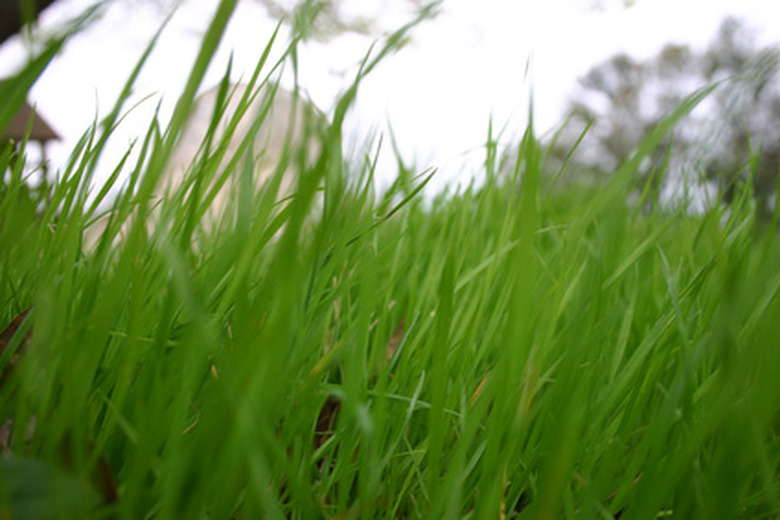How To Weed, Feed & Seed A Lawn In Florida
Things Needed
- Grass seed
- Tiller
- Rake
- Mechanical seeder, optional
- Lawn roller
- Fertilizer
- Lawn mower
- Pre-emergence herbicide
- Post-emergence herbicide
If you want your property to look fully finished and well tended, a well-kept lawn can help complete that image. Sowing a lawn and keeping it thriving in Florida, like most anywhere, can be challenging. By making the right decisions before and during the planting, however, you can eliminate some of the difficulties throughout the rest of the year. After the grass is up, proper care, such as feeding and weeding, keeps your lawn looking at its best.
Seed
Step 1
Choose a drought-resistant grass, such as Bahiagrass, to make maintenance easier. According to the University of Florida, grasses like Bahiagrass do well in sandy soil, which is a plus in Florida, do not need a lot of fertilizing and have few problems with disease. The University of Florida also recommends buying scarified seed, if it's available, which germinates faster.
- If you want your property to look fully finished and well tended, a well-kept lawn can help complete that image.
- Sowing a lawn and keeping it thriving in Florida, like most anywhere, can be challenging.
Step 2
Seed your lawn during the spring or in the early summer. By planting early and giving the grass the entire summer to root, the lawn fully fills in before the fall and winter, when cold weather slows growth.
Step 3
Till and rake the lawn area. Till until 1 to 2 inches of the top soil looks soft and rich, and rake to remove any debris pulled up during tilling, such as rocks and roots, which can interfere with seeding.
Step 4
Use the correct amount of seed for your lawn area. According to the University of Florida, you should plant Bahiagrass at a rate of 10 lbs. per each 1,000 square feet. Other grass types vary greatly in the amount of seed needed, with centipedegrass requiring only 4 oz. of seed for every 1,000 square feet.
- Seed your lawn during the spring or in the early summer.
- Till until 1 to 2 inches of the top soil looks soft and rich, and rake to remove any debris pulled up during tilling, such as rocks and roots, which can interfere with seeding.
Step 5
Spread the seed evenly around the lawn area. Throw the seed by hand or use a mechanical seeder to spread the seed. A mechanical seeder more evenly distributes the seed, according to the University of Florida.
Step 6
Rake the lawn area lightly after seeding. Rake just enough to work the seed down into the soil, so 1/4 to 1/2 inch of soil is on top.
Step 7
Roll the entire lawn area to press the seed into the soil. Mulch with hay or straw to keep the seed from being washed away before it starts to root.
- Spread the seed evenly around the lawn area.
- Roll the entire lawn area to press the seed into the soil.
Feed
Step 1
Wait to apply fertilizer to a newly seeded lawn until the grass establishes a root system. Fertilize for the first time after the grass has fully established and the lawn appears full.
Step 2
Use a complete fertilizer to feed your newly planted lawn. The University of Florida recommends a 16-4-8 fertilizer.
Step 3
Figure the amount of fertilizer needed for your lawn. The University of Florida recommends using ½ lb. of nitrogen if using water-soluble fertilizer or 1 lb. of nitrogen if using slow-release fertilizer for every 1,000 square feet of lawn.
- Wait to apply fertilizer to a newly seeded lawn until the grass establishes a root system.
- of nitrogen if using slow-release fertilizer for every 1,000 square feet of lawn.
Step 4
Fertilize the lawn in the spring, after grass establishment, and again in the late summer or early fall. If the lawn is not thriving, fertilize up to four times in a summer.
Weed
Step 1
Avoid mowing a newly seeded lawn until it is well established. Once it reaches a normal mowing height of 3 to 4 inches, mow the lawn to a height of 2 to 3 inches, depending on your personal preference.
Step 2
Don't use chemicals for weed control if the lawn hasn't shown previous signs of weeds. With proper seeding and fertilization, many lawns never form weeds and the chemicals used to keep them at bay do more harm than good.
Step 3
Create a barrier to prevent weed growth with pre-emergence herbicides in areas where weeds have been troublesome in the past. Pre-emergence herbicides prevent the weeds from coming up if applied at the right time of year. The University of Florida recommends an application date of February 1st for lawns in southern Florida, February 15th for lawns in central Florida and March 1st for lawns in northern Florida.
- Fertilize the lawn in the spring, after grass establishment, and again in the late summer or early fall.
- Once it reaches a normal mowing height of 3 to 4 inches, mow the lawn to a height of 2 to 3 inches, depending on your personal preference.
Step 4
Pull weeds by hand throughout the growing season, or control weeds with post-emergence herbicides if they come up. Be careful when using post-emergence herbicides on lawns. Some types of grass, including Bahiagrass, suffer damage from post-emergence herbicides.
Tip
To determine the amount of nitrogen in a fertilizer bag, multiply the percentage of nitrogen by the total weight of the bag. Since 16-4-8 fertilizer has 16 percent nitrogen, a 100 lb. bag of the fertilizer contains 16 lbs. of nitrogen. With 1 lb. for every 1,000 square feet, the fertilizer should cover 1,600 square feet of lawn.
Warning
Stay away from fertilizers with added chemicals to reduce weeds. These can damage some lawn grasses.
